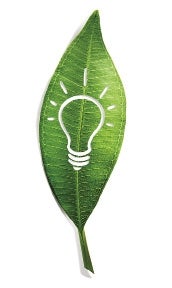Homes powered by sunlight, control systems that regulate every nuance of energy management, waste-conversion systems that turn trash and manure into clean electricity. What was “the stuff that dreams are made of” yesterday is so commonplace in today’s green world that it’s hard to tell the players without a scorecard. If you plan to compete, you’ve got to differentiate your brand. So, here are three marketing tips to get the wheels turning:
1. Create your own brand perception or your competitors will do it for you.
Even in the altruistic world of green energy and environmental sustainability, it’s not always the best mouse trap that becomes the commercial success. Instead, it’s the one that’s perceived as the best. Therefore every green product or service marketer should have a realistic vision of their brand’s current perception — or lack thereof — in the market, and a clear vision of the market perception it wants to eventually achieve. This requires a hard, objective and sometimes uncomfortable reality check on the true strengths and weaknesses of the product and organization.
Every company would like to have its product perceived as the fastest, most cost effective, most durable, most reliable, most accurate, most future proof, etc. But every viable company should be able to define at least one unique value proposition that it can use to distinguish itself from the rest.
2. Risk aversion trumps perceived reward.
While many companies spend most of their marketing efforts touting advanced technology and greater efficiency, some marketers fail to consider how much risk aversion plays into today’s buying decisions, particularly in business-to-business sales cycles when a buyer’s decision can have serious consequences for his or her career. Part of brand building is creating a comfort level that your products will perform and continue to perform as promised. If yours is a well-recognized brand or a large company with deep pockets, you have an advantage here. If you’re a smaller company or a newer market entry, you’re going to have to work harder. News announcements on new sales and partnerships, especially when they involve known and respected companies, are a relatively inexpensive way to create the perception that you’re an active, growing organization that others believe will be around in the future.
3. Never lie, but don’t be afraid to exploit the truth.
Look hard enough and every competitor will have some flaw you can exploit to better position your own product or service. It may be a deficiency under certain operating conditions, poor service and support, difficult-to-obtain replacement parts, or high maintenance fees. Do your research. Find those chinks in the armor and make sure to tell the market about them as often as your resources will allow.
But don’t fabricate competitors’ flaws. This will eventually undermine your credibility and diminish your brand. The goal is to create enough fear, uncertainty and doubt to push buying decisions in your direction. Here’s a simple but effective marketing communications tactic for an ad, website or brochure. Begin a sentence with the phrase “Unlike some other products in the market that …” This puts a competitor on the defensive. If the prospect does not already know to whom you are referring, he will surely ask about this flaw in every subsequent conversation with you and your competitors.
Marc Bane is an independent marketing and communications consultant with more than 13 years of experience with the energy and clean-tech industries. Contact him at mbane@banemarketing.com.

